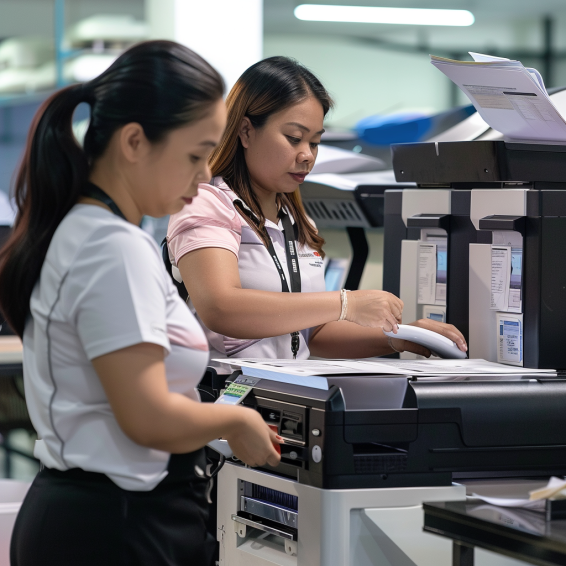
Environmental Impact: Rental vs. Purchase – A Greener Way to Print
Introduction: Environmental Impact: Rental vs. Purchase
When considering how your business uses printers and copiers, one important factor often gets overlooked: the environment. The environmental impact: rental vs. purchase debate is more relevant than ever, especially for businesses aiming to reduce their carbon footprint. Should you buy your printing equipment outright or rent it? The answer can make a big difference not only in cost but also in sustainability.
In this blog post, we’ll explore the ecological implications of renting versus purchasing printers, how each affects waste, energy use, and resource consumption, and why rental options are becoming the smarter, greener choice for modern enterprises.
Understanding the Lifecycle of Printers and Copiers
Purchased Equipment: A Short Lifecycle with High Waste
When companies purchase printers, the equipment is often replaced every 3 to 5 years due to technology upgrades, wear and tear, or the need for better features. Unfortunately, this cycle contributes to:
Increased electronic waste (e-waste)
Premature disposal of still-functional machines
Greater demand for manufacturing new units
Most printers and copiers are composed of plastics, metals, and other non-biodegradable materials. Improper disposal leads to landfill overflow and hazardous materials seeping into the environment.
Rental Equipment: Extending the Useful Life
Printer rental companies like Marga Enterprises follow a circular model. Machines are:
Regularly maintained and refurbished
Reused across different clients and industries
Ultimately recycled or donated once their lifecycle ends
This approach drastically reduces the volume of discarded machines and helps conserve raw materials.
Energy Efficiency and Emissions: A Clear Advantage for Rentals
Energy Use in Manufacturing and Operation
Manufacturing printers and copiers consumes a significant amount of energy. If every company buys its own equipment, demand rises, leading to more production and carbon emissions.
Rental models offset this by:
Reusing the same unit across different clients
Reducing the need for frequent manufacturing
Supporting energy-efficient models through strategic upgrades
Many rental companies, including Marga Enterprises, supply eco-friendly and energy-efficient printers designed for sustainable use, especially in remote work setups (Best Printers for Remote Work).
Consumables and Maintenance: Minimizing Waste
Owned Devices: Higher Risk of Mismanagement
With purchased equipment, businesses often overlook sustainable practices related to:
Toner and ink disposal
Paper consumption
Irregular maintenance leading to inefficient performance
This not only increases environmental damage but also reduces the lifespan of the equipment.
Rented Devices: Managed and Monitored Usage
Printer rental providers typically offer:
Scheduled maintenance
Eco-conscious consumable replacement plans
Proper recycling procedures for ink cartridges and parts
You get peace of mind knowing that your devices are maintained with sustainability in mind. Learn how home offices benefit from such setups.
Reducing Electronic Waste Through Rentals
Electronic waste is one of the fastest-growing waste streams globally. With printer rentals:
Devices are reused rather than discarded
Obsolete parts are repurposed or recycled responsibly
Machines are returned and refurbished, not thrown away
Compare this to outright purchases, where responsibility for end-of-life disposal often falls on the business—many of whom lack proper e-waste channels.
For portable solutions that are reused across locations and departments, check out Portable Printers for Home Offices.
Real-World Impact: Case Studies and Sustainability in Action
Many businesses across the Philippines are switching to rentals not just for convenience, but also to meet their green goals. According to various case studies on remote work printer rentals, companies saw:
30–50% less paper waste due to better tracking
Reduced electricity usage from modern rental machines
Elimination of e-waste handling costs
These real-world examples highlight how rentals provide a measurable impact—not just operationally, but environmentally.
Cost Savings and Environmental Synergy
Renting doesn’t only benefit the environment; it saves you money too. With rentals:
There are no upfront capital expenses
Costs are predictable and bundled with maintenance
You only use what you need, when you need it
This synergy between cost-effectiveness and environmental responsibility is why many businesses are embracing the rental model.
When to Choose Rental Over Purchase
Here’s a quick guide to help you decide:
| Situation | Recommended Option | Why |
|---|---|---|
| Short-term projects | Rental | Avoid unnecessary purchases |
| Growing startups | Rental | Scale as needed without waste |
| Remote offices | Rental | Mobility + environmental savings |
| Long-term office setups | Rental or Purchase | Depending on usage volume and sustainability goals |
If environmental responsibility is part of your brand or company values, printer rental is clearly the more aligned choice.
Conclusion
Making a sustainable choice in office equipment doesn’t have to be complicated. As we’ve explored in the environmental impact: rental vs. purchase, renting is a practical, eco-conscious solution that helps reduce waste, conserve energy, and support a circular economy. By choosing to rent instead of own, you’re not only optimizing your business operations—you’re also helping preserve our planet for future generations.
If you’re looking to harness the benefits of modern, cost-effective copier solutions without the burden of ownership, consider renting your next color copier. To learn more about sustainable copier rental solutions and how Marga Enterprises can support your green initiatives, contact us today at 09171642540 or 09614481276. You can also reach us via email at marga.enterprises2013@gmail.com.
Consider Visiting our Facebook Page.
Visit Marga Enterprises and find out why we are the No. 1 Copier & Printer Rental Provider in the Philippines.
